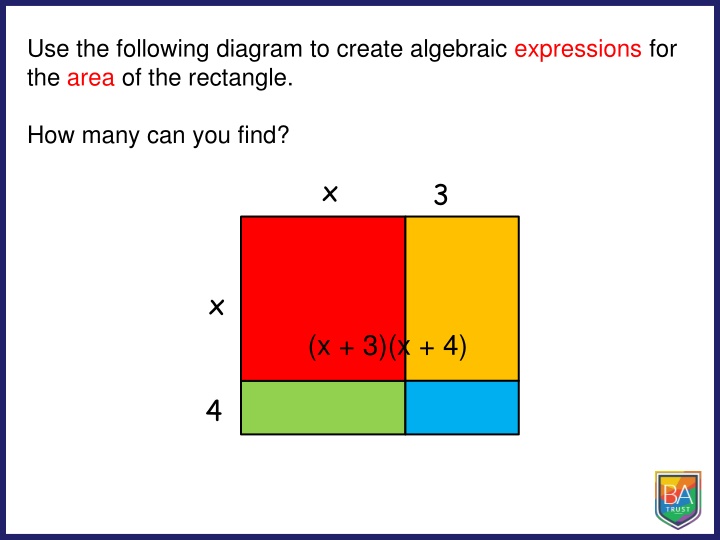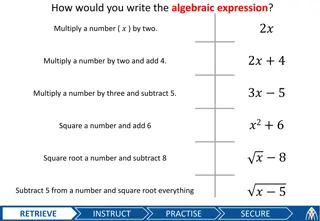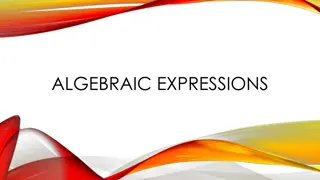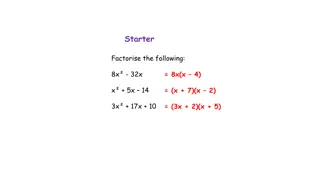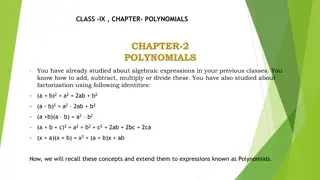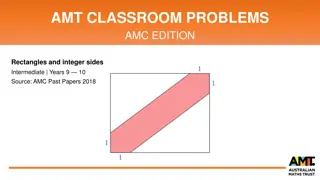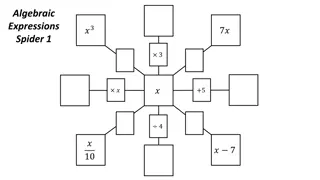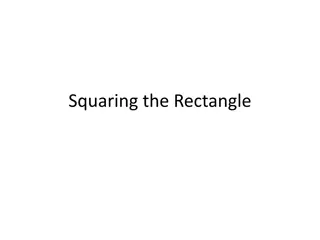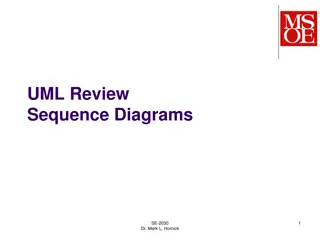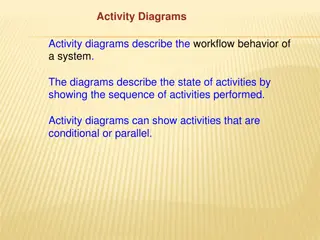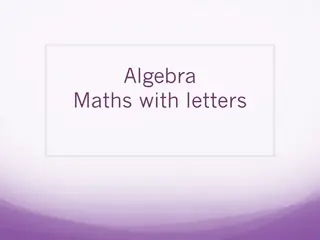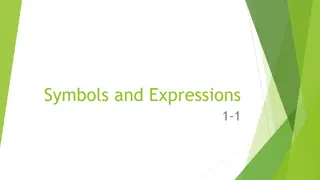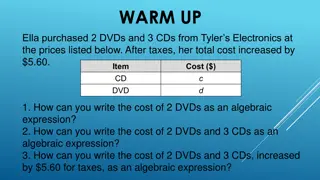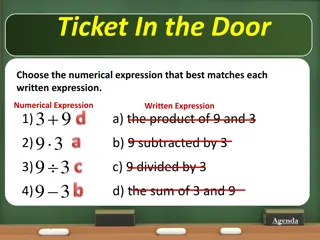Creating Algebraic Expressions for Area of a Rectangle Through Diagrams
In this content, various algebraic expressions for finding the area of a rectangle are explored using diagrams. Through factorization, simplification, and application of the distributive law, multiple equivalent expressions are identified. Quadratic identities and filling gaps in identities are also demonstrated. These concepts help in understanding the algebraic manipulation related to rectangular areas with the use of variables like x, d, g, f, and h.
Download Presentation

Please find below an Image/Link to download the presentation.
The content on the website is provided AS IS for your information and personal use only. It may not be sold, licensed, or shared on other websites without obtaining consent from the author.If you encounter any issues during the download, it is possible that the publisher has removed the file from their server.
You are allowed to download the files provided on this website for personal or commercial use, subject to the condition that they are used lawfully. All files are the property of their respective owners.
The content on the website is provided AS IS for your information and personal use only. It may not be sold, licensed, or shared on other websites without obtaining consent from the author.
E N D
Presentation Transcript
Use the following diagram to create algebraic expressions for the area of the rectangle. How many can you find? x 3 x (x + 3)(x + 4) 4
Use the following diagram to create algebraic expressions for the area of the rectangle. How many can you find? x 3 3x x2 + 7x + 12 x2 x 12 4x 4
Use the following diagram to create algebraic expressions for the area of the rectangle. How many can you find? x 3 x(x + 3) x(x + 3) + 4(x + 3) x 4(x + 3) 4
Use the following diagram to create algebraic expressions for the area of the rectangle. How many can you find? x 3 x(x + 4) + 3(x + 4) x x(x + 4) 3(x + 4) 4
Use the following diagram to create algebraic expressions for the area of the rectangle. How many can you find? x 3 (x + 3)(x + 4) x2 + 7x + 12 x x(x + 3) + 4(x + 3) x(x + 4) + 3(x + 4) 4 The expressions are all equivalent. When expressions are equivalent we use the symbol
Put equivalent expressions together to make an identity Identities are true for all values of x. (x + 3)(x + 4) x2 + 7x + 12 The expression on the left is the fully factorised version. The expression on the right is the fully simplified version. (x + 4)(x + 3) x(x + 3) + 4(x + 3) This combination of expressions is known as the distributive law (x + 3)(x + 4) x(x + 4) + 3(x + 4) And so is this.
Use each diagram to create a quadratic identity b) a) 3x 2x 6 2x 2x 3 2
Fill in the gaps for each identity a) (3x + 5)(2x + 2) x2 + 16x + b) (3d + 4)(4d + 3) 3d( 4d + ) + 4( d + 3) c) (3g + 3)(2g + 6) g2 + 24g + d) (2 + 4f)(3f +2) 3f(2 + f)+ ( + 4f) e) (3h + 2)2 9h2 + h +
Fill in the gaps for each identity a) (3x + 5)(2x + 2) x2 + 16x + 10 6 b) (3d + 4)(4d + 3) 3d( 4d + ) + 4( d + 3) 3 4 c) (3g + 3)(2g + 6) g2 + 24g + 6 18 d) (2 + 4f)(3f +2) 3f(2 + f)+ ( + 4f) 2 2 4 e) (3h + 2)2 9h2 + h + 4 12
Write an expression involving brackets for the area of the red shape 2 2x + 2 Expand and simplify your expression
Write an expression involving brackets for the area of the red shape 2 2x + 2 3x + 2 Expand and simplify your expression
Write an expression involving brackets for the area of the red shape 2 2x + 2 3x + 2 4x + 6 Expand and simplify your expression
Write an expression involving brackets for the area of the red shape x + 2 3x + 1 Expand and simplify your expression
Write an expression involving brackets for the area of the red shape x + 2 3x + 1 3x + 2 Expand and simplify your expression
Write an expression involving brackets for the area of the red shape x + 2 3x + 1 3x + 2 4x + 5 Expand and simplify your expression
In your pairs ABCH is a square HCFG is a rectangle CDEF is a square They are joined to make an L-shape Show that the area of the L- shape, in cm2 is x2 + 9x + 27
In your pairs Hints ABCH is a square HCFG is a rectangle CDEF is a square They are joined to make an L-shape Show that the area of the L-shape, in cm2 is x2 + 9x + 27
In your pairs Hints ABCH is a square HCFG is a rectangle CDEF is a square They are joined to make an L-shape Show that the area of the L-shape, in cm2 is x2 + 9x + 27
In your pairs Hints ABCH is a square HCFG is a rectangle CDEF is a square They are joined to make an L-shape Show that the area of the L-shape, in cm2 is x2 + 9x + 27
If you have finished, try this one ABCH is a square HCFG is a rectangle CDEF is a square They are joined to make an L-shape Find as many expressions, in terms of a and b for the area of the L- shape as you can. (b + 2) cm Show that they are all equivalent. (a + b) cm
Write an expression involving brackets for the area of the red shape 2x + 3 3x + 1 Expand and simplify your expression
Write an expression involving brackets for the area of the red shape 2x + 3 x + 2 3 3x - 1 (2x + 3)(3x 1) 3(x + 2) Expand and simplify your expression
Write an expression involving brackets for the area of the red shape 2x + 3 x + 2 (2x + 3)(3x + 1) 3x + 1 3 3(x + 2)
Write an expression involving brackets for the area of the red shape 2x + 3 x + 2 6x2 9x 3x 3x 3 6 2x 3 +1 (2x + 3)(3x + 1) 3(x + 2)
Expand and simplify your expression 2x + 3 x + 2 6x2 9x 3x 3x 3 6 2x 3 +1 (2x + 3)(3x + 1) 3(x + 2) 6x2 + 11x + 3 [3x + 6] 6x2 + 11x + 3 3x - 6 6x2 + 8x 3
In your pairs The diagram shows two rectangles. All dimensions are in cm. Work out an expression, in terms of x, for the shaded area. Give your answer in its simplest form.
Find the area of the shaded region for each shape 2h + 4 a) b) n + 1 h + 2 3h + 1 4 2n + 1 2h + 1 n + 2
Challenge problem Write an expression involving brackets for the area of this trapezium. Expand and simplify your answer y 2y y + 2
Challenge problem Write an expression involving brackets for the area of this trapezium. Expand and simplify your answer y 2y 2y2 + 2y y + 2
